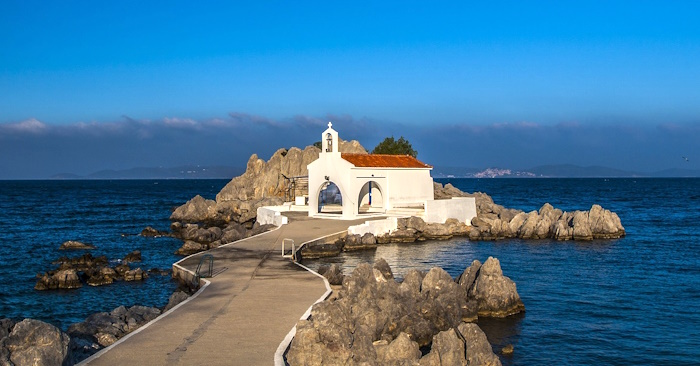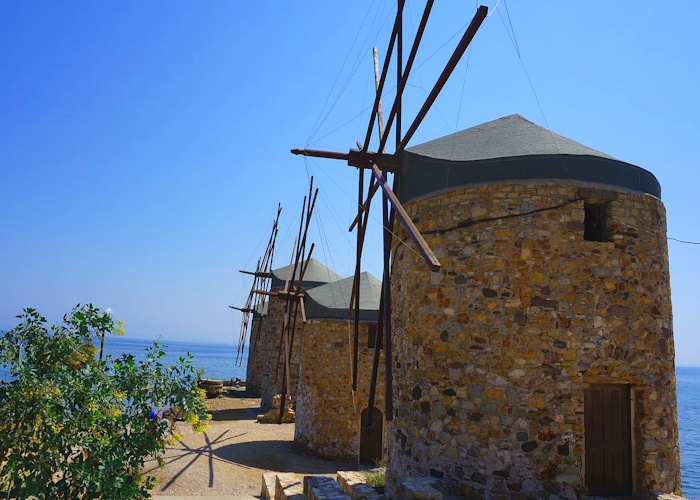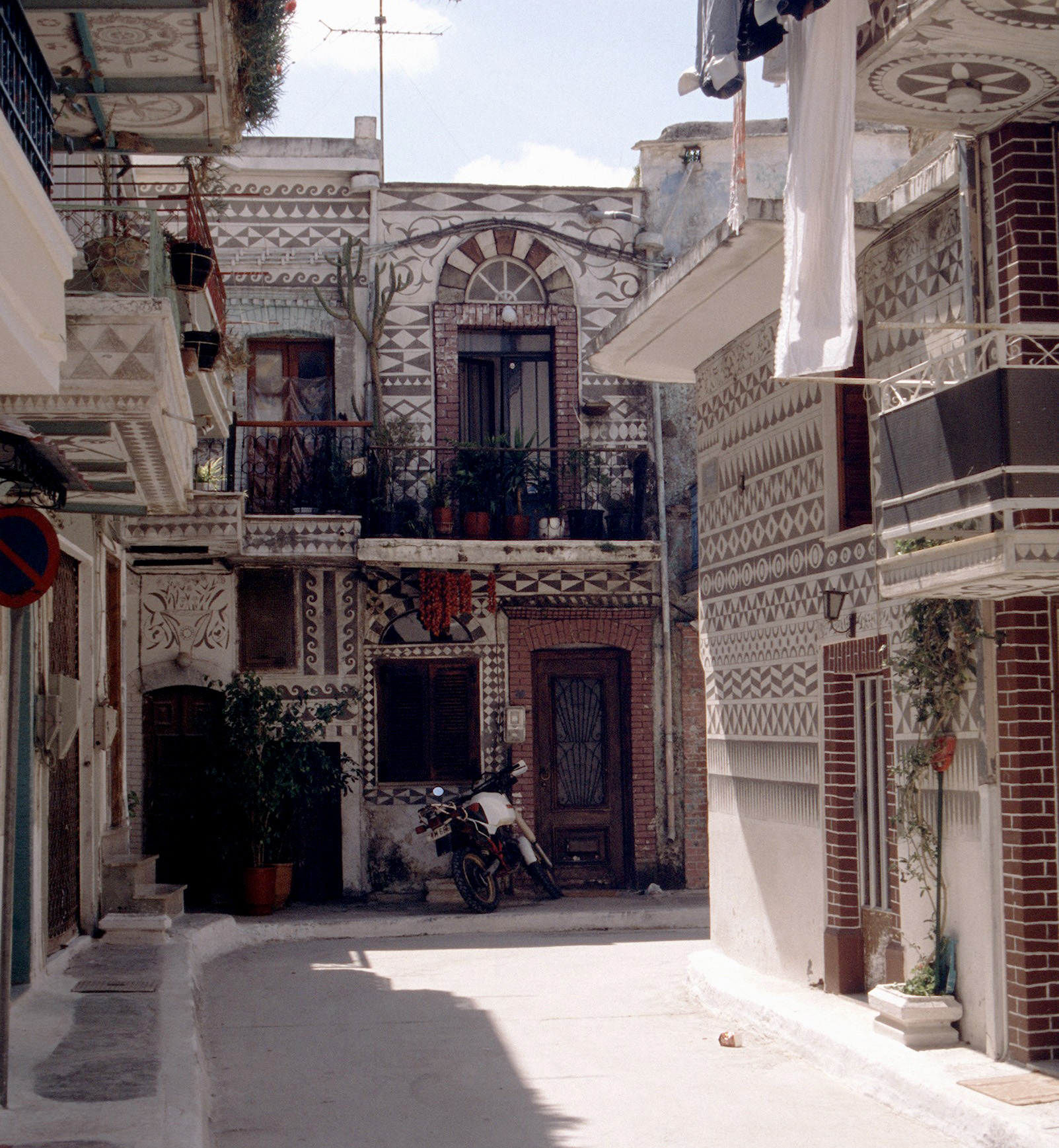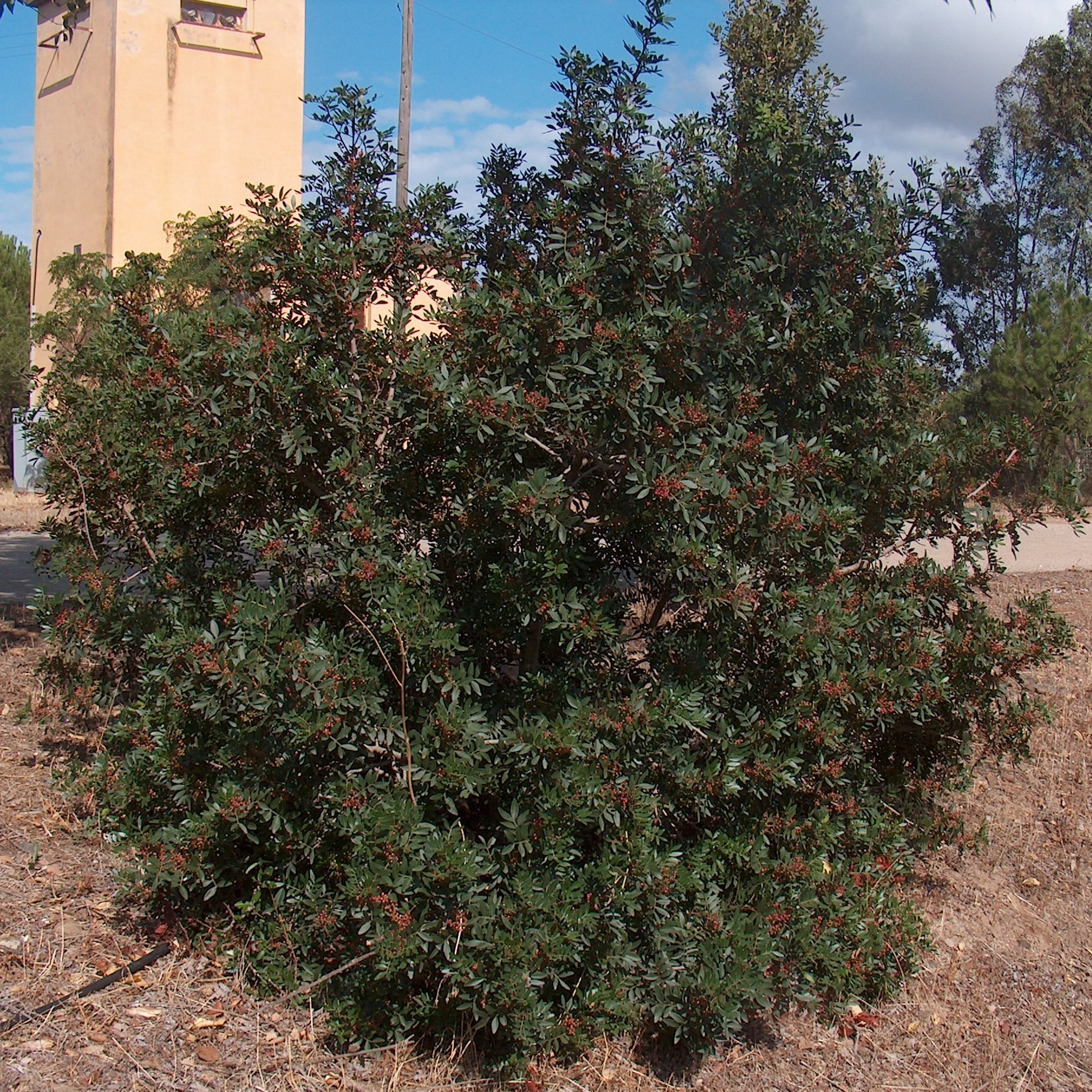The island of Chios is located in the Eastern Aegean Sea about 10 km off the Turkish coast and 50 km south of Lesbos. The large island has an area of almost 850 square kilometers (7th largest island in Greece) and about 52,000 inhabitants (as of 2024). The capital and ferry port is Chora (usually simply called Chios Town), with about 26,000 inhabitants. The highest mountain on Chios is Pelineo at 1,300 meters.

There is tourism, but less than on many other large islands in Greece. There are not too many sights on Chios. The “Neo Moni” (New Monastery) is known for its mosaic collections. It is located 15 km west of Chios town. The village of Pyrgi is extremely interesting with its small streets, painted facades and beautiful Greek island architecture. The Korais Library in the capital with 95,000 books, the winding streets of the old town and the 10th century castle in Chios town are worth seeing.
There are hotels and guest houses in Chios town and in some other places. You can also find simple rooms to rent or guest houses in the smaller villages. Since Chios has a university with over 1000 students, the town has a strong nightlife for younger people. In total, there are eight municipalities on the island of Chios, each of which usually consists of several villages. The most popular village for tourists is Pyrgi in the south of the island of Chios. Here you will find Maxtris, the Maxtris Museum and beautifully painted houses.
Our impression of Chios: A very interesting island that actually deserves more attention and tourists.
Tip: Book hotels & holiday apartments cheaper at Booking.com: Click here
Mastic of Chios
The island of Chios is known for its mastic trees. The resin from the mastic tree (a subspecies of pistachio) is used, among other things, to make chewing gum, glue, as a protective coating for oil paintings and mouthwash. The mastic resin of Chios is extremely expensive, a kilogram costs up to 100 euros. But you need about 8 trees to make a kilo. Many villages on Chios, especially in the south of the islands, live from mastic. Chios is the largest mastic producer in the world.
Homer and Columbus of Chios?
The poet Homer was probably born on Chios in the eighth century BC. Homer is considered to be the first writer in Europe whose texts still exist today. Two works by Homer have survived: the Iliad and the Odyssey (these are the world-famous wanderings of Odysseus). Whether Homer is actually the author of these two stories is not entirely undisputed.
There are also repeated rumors that the famous explorer and discoverer of America Christopher Columbus was born on Chios. The majority of researchers believe, however, that Columbus comes from the Genoa region in Italy. At least Columbus is a common surname on the island of Chios.
Ferries Chios
In summer there are daily ferries to Cesme (in Turkey), to Piraeus (the port of Athens) and to Lesbos. There are ferry connections to other islands in the area such as Samos and island Limnos several times a week. There are also often smaller ships that connect Chios with the offshore dwarf island Psara and Inousses. The ferry port is in the center of the city. The ferries to Turkey are used a lot by tourists. Unfortunately, the tickets are not cheap at around 35 euros for the short journey (under 1 hour journey time), international ferries are often more expensive in Greece. Large ferries are car ferries, so you can also take your own vehicle with you.
➔ To book ferries within Greece, we recommend the reputable website Ferryscanner.com
Flights Chios
There are daily flights from the small airport on Chios to Athens and Thessaloniki. There are hardly any charter flights from abroad. However, you can fly to the nearby island of Lesbos and travel on to Chios by ferry. Alternatively, you can take a plane to Athens or Thessaloniki and change. However, you should check beforehand whether there is a ferry connection.
Refugees Chios
In recent years, many refugees from nearby Turkey have come to Chios. Reports about the refugee camps on Chios have been shown on television all over Europe. This has had a very negative impact on tourism on the island. There are far fewer tourists than before. Unjustly, say most residents and tourists who still come. The refugees hardly change a vacation.
Map
|
At one point, Chios is only about 5 kilometers from the mainland (Turkey). Many refugees, including from Syria, have been coming to the island since around 2015. The island of Inousses and the island of Psara are smaller neighboring islands. |
Bus or rental car in Chios?
There are regular buses on the island. The blue buses are the local buses for Chios town and the surrounding area, the green buses go to villages further away on Chios. The bus connections to the villages in the south are OK, but there are even fewer regular services in other regions of Chios. Unfortunately, the buses run quite rarely overall, even in summer to the famous Maxtris village of Pyrgi only about 3 times a day.
If you want to see the whole island of Chios, it is better to rent a car or moped. There are several car rental companies in the capital. There are also rental cars directly at the airport. There are many taxis on Chios, which, unlike on the other islands, are red here.
Chios: Top 10 sights and activities
1.Mastixochoria (mastic villages)
Visit the medieval villages of Pyrgi and Mesta, known for their unique architecture and the cultivation of mastic (a valuable resin). Very interesting, for us Pyrgi in particular is the highlight of Chios.
2.Olympi Cave
This impressive stalactite cave offers spectacular formations and is a highlight for nature lovers.
3.Chios Town (Chora)
Explore the capital with its Venetian castle, harbor and charming cafes and restaurants.
4.Nea Moni Monastery
This 11th century UNESCO World Heritage Site is famous for its Byzantine mosaics.
5.Karfas Beach
A family-friendly sandy beach ideal for relaxing and water sports.
6.Anavatos
An abandoned medieval town, also known as the “ghost village,” with fascinating ruins and a dramatic hilltop location.
7.Emporios and Mavra Volia Volcanic Beach
A unique beach with black pebbles from an ancient volcanic eruption.
8.Agia Markella
This monastery in the north of the island has spiritual and historical significance and offers stunning views.
9.Aegean Pirate Museum
Learn about the island’s rich maritime history and its role in fighting pirates.
10.Hiking and Nature
Explore the green landscapes, pine forests and hills of Chios, especially in spring when the wildflowers bloom.
Chios Town (Chios City, Chora)
Chios Town, also known simply as Chora, is the capital and main port of the Greek island of Chios in the northern Aegean Sea. As the cultural, economic and administrative centre of the island with a population of around 25,000, Chios Town combines modern amenities with a rich historical past and offers visitors a variety of attractions to explore.
 Very famous are the windmills of Chios, a landmark of the island in eastern Greece.
Very famous are the windmills of Chios, a landmark of the island in eastern Greece.
Chios Town’s main highlights:
Chios Castle:
The medieval castle, located near the harbor, is a historical landmark. The thick walls, narrow streets and remains of Ottoman and Genoese architecture offer a glimpse into the island’s turbulent history.
Waterfront:
The lively harbor area is ideal for a leisurely stroll. Here you will find a mix of cafes, restaurants and shops overlooking the sea.
Korais Library:
The Korais Library is one of the largest libraries in Greece and also houses the Argenti Folklore Collection, which showcases the cultural heritage of Chios.
Agia Paraskevi Park:
A peaceful green area within the town where locals and tourists can relax.
Shopping and Dining:
Chios Town is known for its traditional Maxtris products, such as liquors, sweets and cosmetics. Don’t miss out on trying local delicacies such as souma, fish dishes and fresh pastries.
Pyrgi, Chios – The Painted Village
Pyrgi (or also spelled Pirgi) is one of the most famous villages on the Greek island of Chios. It is located in the southern part of the island, about 25 km from Chios Town. Known as the “painted village”, it is known for its unique architecture and decoration with intricate geometric patterns on the facades of the houses, setting it apart from other settlements.
Xysta Facades:
The most striking feature of Pyrgi is the traditional “Xysta” decoration on the house facades. These intricate black and white geometric patterns are created by carving patterns into a plaster surface, a technique influenced by Genoese art. Almost every house in the village is decorated with these beautiful patterns.

By Mätes II. – Own work, CC BY-SA 3.0, Link
Narrow streets and architecture:
The streets of Pirgi are narrow and labyrinthine to protect the village from pirates in the Middle Ages. The buildings are close together, giving the village a fortress-like appearance.
Church of the Holy Apostles:
This 13th-century Byzantine church is a must-see attraction, with beautiful frescoes and architectural details reminiscent of the famous Nea Moni Monastery.
Mastic production:
Pyrgi is located in the “Mastichochoria” region of Chios, which is famous for the production of mastic, a resin found only on the island. Visitors can learn about the cultivation and processing of mastic, which has been an important part of Chios’ economy and culture for centuries.
Mastic of Chios – a unique treasure
Mastic or “masticha” is a natural resin harvested primarily on the Greek island of Chios, in the southern region known as Mastichochoria (mastic villages). Often referred to as “Chios tears”, this rare product is known for its unique taste, health benefits and cultural significance.
The following picture shows the mastic plant (Pistacia lentiscus), more of a shrub than a tree:
 By Giancarlo Dessì (Posted by —gian_d 15:05, 13 November 2006 (UTC)) – Professional Institute of Agriculture and Environment “Cettolini” of Cagliari (Sardinia, Italy), CC BY-SA 3.0, Link
By Giancarlo Dessì (Posted by —gian_d 15:05, 13 November 2006 (UTC)) – Professional Institute of Agriculture and Environment “Cettolini” of Cagliari (Sardinia, Italy), CC BY-SA 3.0, Link
What makes mastic so special?
Mastic is obtained from the mastic tree (Pistacia lentiscus var. chia), which thrives in the special soil and climate of southern Chios. When the bark is gently scratched, the resin oozes out and hardens into tear-like drops. This process and the tree’s unique growing conditions make mastic an exclusive product with a Protected Designation of Origin (PDO).
Uses of mastic
Food: Mastic gum: Used as a natural chewing gum with a distinct, slightly piney taste.
Sweets and baked goods: Adds a unique flavor to traditional Greek desserts, breads and ice cream.
Liqueurs: A main ingredient in mastic liquor (masticha), a popular digestif.
Medicine: Known since ancient times for its digestive properties.
It is known for its antibacterial and anti-inflammatory properties and is often used to support oral and intestinal health.
Research suggests possible benefits in treating stomach ulcers.
Cosmetics: Used in skin care products for its rejuvenating and antioxidant properties.
Found in soaps, creams and essential oils.
Known since ancient times for its digestive properties.
It is known for its antibacterial and anti-inflammatory properties and is often used to support oral and intestinal health.
Research suggests possible benefits in treating stomach ulcers.
Mastic Museum: Learn about the history, cultivation and uses of mastic. Located near the village of Pyrgi in southern Chios.
Harvesting demonstrations: See how mastic is traditionally harvested during the summer months.
Local markets: Buy authentic mastic products directly from the producers.
Mastic is available in various forms: raw resin, powder, capsules, candy and cosmetics. Look for it in specialty shops on Chios, Greek pharmacies or online stores.
A true gem of Greek culture, mastic offers a mix of history, tradition and versatile uses. Whether for cooking, health or beauty, it is a product that connects you to the island’s rich heritage.
Nea Moni Monastery on Chios – Visitor Information
A UNESCO World Heritage Site, Nea Moni Monastery is located about 12 km west of Chios Town in a picturesque mountainous landscape. It dates back to the 11th century and is famous for its well-preserved Byzantine mosaics.
Opening hours
Summer: Daily from 08:00 to 20:00.
Winter: Daily from 08:30 to 15:30.
Closed on certain religious holidays.
Entrance fee
Regular: approx. €4
Reduced: approx. €2 (e.g. students, seniors)
Children and EU students: Free
Tips for visitors
Clothing: Respectful clothing is required (shoulders and knees covered).
How to get there: Accessible by car or taxi from Chios town, limited bus connections.
Duration: Plan around 1-2 hours for the visit.
The monastery offers a unique combination of spiritual tranquility and impressive art history.
Mavra Volia – The Volcano Beach on the Island of Chios
Mavra Volia is one of the most impressive beaches on the Greek island of Chios, known for its black pebbles and crystal clear water. The beach is located near the village of Emporios on the southern tip of the island and owes its appearance to volcanic activity in the past.
Special features
Black pebbles: The dark stones are the result of a prehistoric volcanic eruption and give the beach its unique appearance.
Crystal clear water: Ideal for swimming and snorkeling.
Untouched nature: The beach is undeveloped and exudes a special tranquility.
Visitor information
Access: Mavra Volia consists of three sections separated by small rocks. The first is easily accessible, the others require short walks.
Infrastructure: No umbrellas, loungers or food – bring everything you need with you.
Best time: Morning or outside of peak season to enjoy the beach in peace.
Nearby
Emporios: A charming fishing village with tavernas serving fresh seafood.
Foki Beach: Another quiet beach nearby, ideal for a change of pace.
Mavra Volia is a must for nature lovers and offers an unparalleled bathing experience in a spectacular setting.
Olympi Cave in the south of Chios Island
Olympi Cave (Spilaio Olympi) is a fascinating stalactite cave near the medieval village of Olympi in the south of Chios Island. Famous for its impressive stalactites and stalagmites, the cave offers a unique natural experience.
Highlights of the cave
Stalactites and stalagmites: The formations have been created over thousands of years and are among the most beautiful on the Greek islands.
Depth and length: The cave extends about 55 meters into the depths with several chambers.
Atmosphere: The lighting makes the stalactites look particularly impressive.
Visitor information
Location: About 5 km from the village of Olympi.
Opening hours:
Summer: Daily from 10:00 a.m. to 6:00 p.m.
Winter: Shorter opening hours, often only on request.
Entry: Approx. €5 per person (reduced approx. €3).
Guided tour: Tours are only possible with guided tours, which last around 30 minutes.
Tips for visitors
Shoes: Wear sturdy shoes as the floor in the cave can be slippery.
Temperature: It is cool in the cave (approx. 18 °C) – a light sweater can be comfortable.
Reservation: In high season, advance booking is recommended.
Nearby
Olympi village: Explore the historic village with its narrow streets and enjoy local specialties in a tavern.
Mastichochoria: Combine a visit to the cave with a trip to the mastic villages of Pyrgi or Mesta.
Olympi Cave is an unforgettable destination for nature and geology enthusiasts!
Hiking on Chios Island
Chios is a beautiful island in the Aegean Sea that is great for hiking. It offers a diverse landscape with picturesque villages, olive groves, pine forests and spectacular coastal views. Here are some of the most popular hiking areas and routes on Chios:
1. Anavatos and surroundings
Description: An abandoned village on a steep cliff, Anavatos is a historical highlight. The hiking trails lead through unspoilt nature and offer impressive views.
Recommendation: Start in Anavatos and explore the surrounding hills and gorges. The route is moderately challenging.
2. Nea Moni and Karyes
Description: This route connects the UNESCO World Heritage monastery of Nea Moni with the picturesque village of Karyes. The trail leads through dense pine forests and has a spiritual atmosphere.
Length: About 5 km.
Difficulty level: Easy to moderate.
3. Mastic Villages (Mastichochoria)
Description: Chios is known for mastic cultivation. A hike through the mastic villages such as Pyrgi and Mesta is a cultural and scenic experience. The trails lead through fields and small streets.
Tip: Combine the hike with a visit to the traditional architecture and mastic products.
4. Daskalopetra and Homer Rock
Description: This historical hiking trail leads to Daskalopetra, a place associated with Homer. The route is easy and offers beautiful views of the sea.
Difficulty level: Easy.
5. Kardamyla Coast
Description: Along the northern coast of Chios there are hikes with breathtaking views of the Aegean Sea. Kardamyla is a good starting point.
Special feature: Discover remote beaches and small chapels along the way.
Tips for hiking on Chios:
Best time to travel: Spring (April to June) and autumn (September to October) offer pleasant weather.
Equipment: Bring sturdy shoes, sun protection and plenty of water.
Hiking maps: There are good hiking maps, but the trails are not always perfectly signposted. A GPS device or hiking app can be helpful.
Guided tours: Local guides offer hikes that provide interesting insights into the history and nature of the island.
Have fun exploring the hiking trails on Chios!
Day trip from Chios to Turkey (to Cesme)
A day trip from Chios to Turkey is a great opportunity to explore the nearby coastal town of Çeşme. Here you can find all the important information:
1. Getting there: Ferries from Chios to Cesme
Duration of the crossing: The ferry from Chios to Cesme takes about 20-35 minutes, depending on the provider.
Provider: There are several ferry companies that offer daily connections.
Turyol and Ertürk Lines are well-known operators.
Cost: Tickets cost around 25-40 euros for a return trip.
Departure:
Chios Port (Chora) for departure.
In Cesme, the ferry docks right at the port near the old town.
Tip: Book tickets in advance, especially in high season (summer).
2. What to see and do in Cesme?
Historical Highlights
Cesme Castle:
An impressive 16th-century fortress with a museum showcasing the region’s history. The view from the castle is spectacular.
Cesme Old Town:
Stroll through the charming streets with traditional houses, boutiques and cozy cafes.
Karavanserai:
A historic trading post that now houses a hotel and restaurant.
Beaches
Ilıca Beach:
Famous for its warm, shallow waters and white sand. Perfect for a relaxing afternoon.
Alacati:
This nearby village is known for windmills, surfing and its picturesque atmosphere. It is only about 15 minutes from Çeşme.
Culinary and shopping
Bazaar and markets:
Visit the traditional market and discover local products such as spices, handmade textiles and Turkish jewelry.
Eating:
Try Turkish specialties such as doner kebab, kebab, meze (starters) and baklava (dessert).
3. Practical information
Travel documents:
For EU citizens, a passport is usually sufficient. A visa may not be necessary for Turkish territory if you are only staying for a short time (depending on your nationality).
Check the current entry requirements for Turkey.
Currency:
In Çeşme, payment is made in Turkish lira (TRY). However, many shops and restaurants also accept euros or credit cards.
Time difference:
Turkey is one hour ahead of Greece (e.g. 12 noon in Chios = 1 p.m. in Çeşme).
4. Return
Ferries usually return in the afternoon or early evening. Make sure you get to the port in good time so you don’t miss the return trip.
A day trip to Çeşme is ideal for getting a taste of Turkish culture and hospitality. Enjoy your adventure!
Animals Chios
The island of Chios, a Greek island in the Aegean Sea, is home to a fascinating wildlife that includes both wild and domesticated species. Here is an overview of the animals that can be found on Chios:
Wildlife
Jackals: Chios is particularly famous for its golden jackals that live in the forests and remote areas.
Birds: The island is a paradise for birdwatchers. Common species include hoopoes, bee-eaters and various birds of prey such as hawks and buzzards.
Reptiles: There are numerous species of lizards, turtles and harmless snakes on the island.
Bats: Caves and old buildings are home to various species of bats.
Domesticated animals
Goats and sheep: These are common and are often used in agriculture.
Donkeys: Traditionally used as working animals, they can still be seen occasionally on the trails.
Cats and dogs: There are many stray cats in the villages and towns, and they are often fed by locals and tourists.
Marine life
Fish: The waters around Chios are rich in fish such as sea bream, grouper and sardines.
Sea turtles: Loggerhead turtles can occasionally be spotted.
Dolphins: Dolphins can be seen offshore if you are lucky.
Special notes
Mastic crops and animals: The island’s mastic villages cultivate the famous mastic trees, and animals such as goats are often carefully kept away to protect the plants.
Protected areas: Some areas of the island, such as the forests in the north, are particularly important as sanctuaries for wildlife.
If you want to explore the wildlife on Chios, hiking in the forests, boat trips and visits to the traditional villages are all good options.
Snakes on Chios
The mountain viper is the poisonous snake in this region (eastern Greece and parts of Turkey). A snake that is also dangerous to humans. The bite has serious consequences but is rarely fatal. If you are bitten, go to a hospital immediately. There are also other, non-poisonous snakes on the island of Chios and other islands in the area.
Museums Chios
Archaeological Museum of Chios
Location: Chios Town (Chora)
Highlights: Artifacts from ancient times including ceramics, sculptures and everyday objects collected from different parts of the island. The museum offers a good overview of the island’s history from prehistoric times to the Roman era.
Special feature: Archaeological finds from Emporio and other significant sites.
Byzantine Museum of Chios
Location: Inside the Ottoman Mosque in the main square
Highlights: Icons, mosaics and artefacts from the Byzantine and Ottoman periods.
Special feature: The mosque itself is a historical building reflecting the island’s Ottoman past.
Maritime Museum of Chios
Location: Chios Town
Highlights: Model ships, maritime maps and items showing the island’s rich maritime history.
Special feature: The exhibition is also dedicated to the famous shipping companies of Chios, which play a central role in the Greek shipping sector.
Argentis Library and Philipp Argenti Museum
Location: Also in the capital
Highlights: Historical documents, rare books and paintings that provide insights into the cultural history of Chios.
Special feature: An impressive collection of writings and artworks from the time of the Greek Revolution.
Kallimasia Folklore Museum
Location: Kallimasia, a village south of Chios town
Highlights: Traditional clothing, tools and furniture that show life on Chios in earlier times.
Special feature: Authentic replicas of traditional houses and work spaces.
Chios Mastic Museum
Location: Near Pyrgi, in the south of the island of Chios
Highlights: Everything about the production and processing of mastic, the famous resin of Chios.
Special feature: A modern museum that offers interactive exhibitions and explains the importance of mastic for the local economy and culture.
A must-see!
➔ Book cheap hotels for 2025 now
Insel Chios ( ![]() Deutsche Version)
Deutsche Version)
Do you have any feedback, an addition, found an error or a comment? Send us an email to: mail@griechenland-insel.de